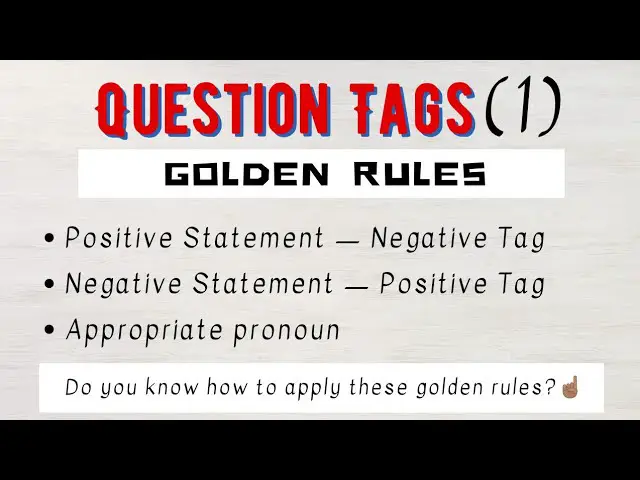A question tag is a “tag” at the end of a statement to make it a “question”.
Learn the basic rules of question tags in English with examples and questions for you to practice.
▶️ Watch this lesson
Examples of question tag
- isn’t he?
- are they?
- didn’t she?
Structure of question tags
See from the examples above that a question tag is made up of just two words — a verb first, then a pronoun.
- A verb (is, are, did, etc.)
- A pronoun (he, she, they, etc.)
In a full sentence format, you’d have two structures — the statement first before the question tag.
- The statement (He is at home.)
- The question tag (isn’t he?)
Basic rules of question tags in English
A statement or question tag is negative when it contains “not, no, none” or any other word that indicates absence.
- Did not (Didn’t)
- No one…
- None of…
While a statement or question tag is positive in the absence of “not, no, none”.
- Did
- One of...

1. Use negative tag for positive statement
When the statement is positive, use a negative question tag.
- She is here — (POSITIVE STATEMENT)
- Isn’t she? — (NEGATIVE TAG)
2. Use positive tag for negative statement
When the statement is negative, use a positive question tag.
- She is not here — (NEGATIVE STATEMENT)
- Is she? — (POSITIVE TAG)
3. Change the subject to a pronoun
When the subject in the statement is a noun (name), change it to the correct pronoun in the question tag.
- DEBORAH is here
- Isn’t SHE?
Another example.
- MUSA and CHUKS are best friends
- Aren’t THEY?
Practice questions on rules of question tags in English
ALSO SEE:
- QUESTION TAGS WITH AUXILIARY VERB
- QUESTION TAGS WITHOUT AUXILIARY VERBS
Do you have something to say about this post on the rules of question tags in English? Let me know in the comments below.

 ‘I teach English online’ to help you communicate better.
‘I teach English online’ to help you communicate better.
Leave a Reply